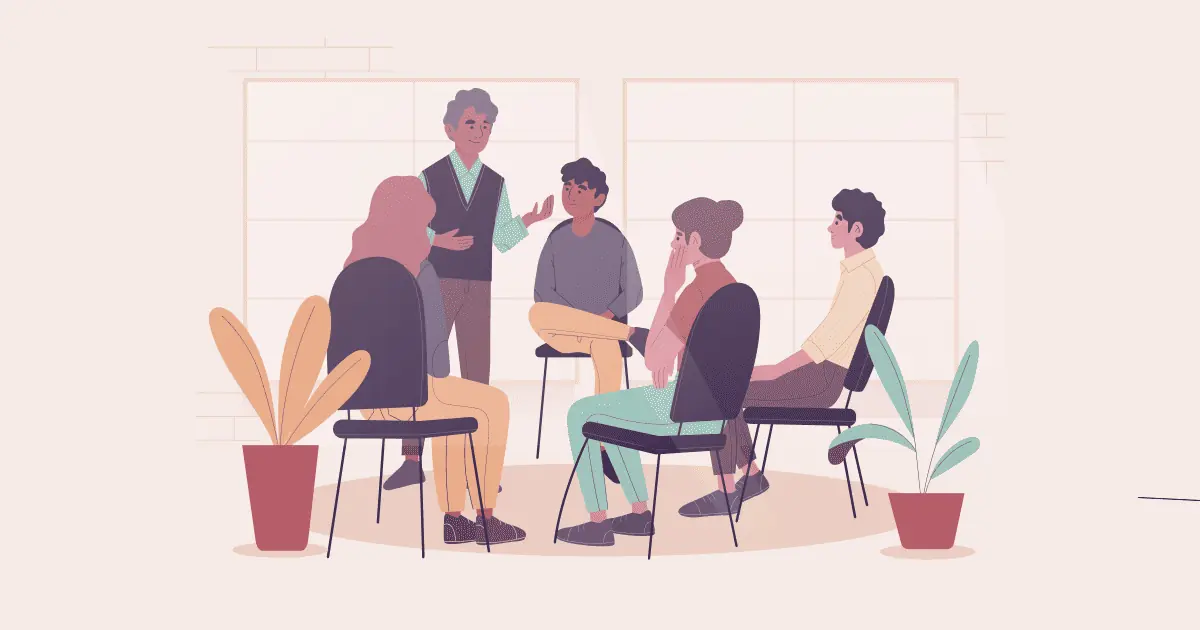Co twoje mowa ciała podczas prezentacji mówi o Tobie? Co robić, a czego nie! Poznajmy najlepsze wskazówki z AhaSlides!
Więc jaka jest najlepsza postawa do prezentacji? Masz syndrom niezręcznych rąk? Prawdopodobnie nie, bo właśnie to wymyśliłem. Ale – wszyscy mamy chwile, kiedy nie wiemy, co zrobić z rękami, nogami lub jakąkolwiek częścią ciała.
Możesz mieć fantastyczną lodołamacz, bez zarzutu wprowadzeniei doskonała prezentacja, ale sposób przekazu jest tam, gdzie jest on najważniejszy. Nie wiesz, co ze sobą zrobić, i to jest idealne normalna.
Omówienie
| Jaka jest mowa ciała zawstydzenia? | patrzenie w dół, kontrola uśmiechu, odwrócone ruchy głowy i dotykanie twarzy |
| Jakie są niewerbalne oznaki wstydu?? | Opuszczone ramiona, pochylona głowa, patrzenie w dół, brak kontaktu wzrokowego, niespójna mowa |
| Czy publiczność wyczuje, kiedy prezenterzy są nieśmiali? | Tak |
| Dlaczego prezentacja Steve’a Jobsa była tak dobra? | On po prostu dużo ćwiczył i jednocześnie się interesował stroje do prezentacji |

Wskazówki dotyczące lepszego zaangażowania
- Osobowość w prezentacji
- Jak wyrażasz siebie?
- Zastosowanie żywe chmury słów or na żywo pytania i odpowiedzi do przeprowadź ankietę wśród swoich odbiorców łatwiej!
- Zastosowanie narzędzie do burzy mózgów skutecznie przez Tablica pomysłów AhaSlides

Zacznij w kilka sekund.
Uzyskaj bezpłatne szablony do następnej interaktywnej prezentacji. Zarejestruj się za darmo i weź to, co chcesz z biblioteki szablonów!
🚀 Pobierz szablony za darmo
W jakim stopniu wiesz o udanej prezentacji? Oprócz dobrze zaprojektowanych szablonów PowerPoint, ważne jest wykorzystanie innych umiejętności wykonawczych, zwłaszcza mowy ciała.
Teraz, gdy już wiesz, że mowa ciała jest niezastąpionym elementem umiejętności prezentacyjnych, wciąż daleka droga przed Tobą, zanim opanujesz tę umiejętność i będziesz wygłaszać skuteczne prezentacje.
W tym artykule znajdziesz holistyczne spojrzenie na mowę ciała i dowiesz się, jak wykorzystać tę umiejętność w swoich prezentacjach.
Spis treści
- Omówienie
- Wskazówki dotyczące lepszego zaangażowania
- Znaczenie mowy ciała podczas prezentacji
- 10 wskazówek, jak opanować mowę ciała podczas prezentacji
- 4 wskazówki dotyczące gestów ciała
- Najczęściej zadawane pytania
Znaczenie mowy ciała w prezentacji
W przypadku prezentacji mowy ciała, jeśli chodzi o komunikację, wspominamy o terminach werbalnych i niewerbalnych. Ważne jest, aby pamiętać, że te terminy mają względny związek. A zatem, czym on jest?
Komunikacja werbalna polega na używaniu słów do dzielenia się informacjami z innymi ludźmi, w tym języka mówionego i pisanego. Na przykład słowo „jak leci”, które wybierasz, aby dać innym do zrozumienia, co próbujesz im powiedzieć.
Komunikacja niewerbalna to przekazywanie informacji za pomocą mowy ciała, mimiki twarzy, gestów, stworzonej przestrzeni i nie tylko. Na przykład uśmiech, gdy kogoś spotykasz, przekazuje życzliwość, akceptację i otwartość.
Niezależnie od tego, czy jesteś tego świadomy, czy nie, wchodząc w interakcje z innymi, nieustannie dajesz i odbierasz sygnały bez słów, oprócz mówienia. Wszystkie twoje niewerbalne zachowania — twoja postawa, intonacja, gesty, które wykonujesz, i to, jak często nawiązujesz kontakt wzrokowy — przekazują istotne komunikaty.
W szczególności mogą one uspokoić ludzi, zbudować zaufanie i zwrócić uwagę, lub mogą obrazić i zdezorientować to, co próbujesz wyrazić. Te komunikaty nie kończą się, gdy przestajesz mówić. Nawet gdy milczysz, nadal komunikujesz się niewerbalnie.
Podobnie, prezentacja jest również sposobem komunikowania się z publicznością; podczas mówienia o swoim pomyśle, pokaż mowę ciała, aby go podkreślić. Zatem zrozumienie znaczenia umiejętności komunikacji niewerbalnej i werbalnej jednocześnie pomoże Ci uniknąć nudnych prezentacji.
Aby było to jeszcze bardziej przejrzyste, przyjrzymy się elementom mowy ciała, części umiejętności komunikacji niewerbalnej. Mowa ciała obejmuje gesty, postawy i mimikę twarzy. Podczas prezentacji, mocna i pozytywna mowa ciała staje się potężnym narzędziem do budowania wiarygodności, wyrażania emocji i nawiązywania kontaktu ze słuchaczami. Pomaga również słuchaczom bardziej skupić się na Tobie i Twojej przemowie. Tutaj przedstawiamy ponad 10 przykładów języka ciała i wskazówek, jak wykorzystać swoją
10 wskazówek, jak opanować mowę ciała podczas prezentacji
Rozważ swój wygląd
Po pierwsze, podczas prezentacji należy zadbać o schludny wygląd. W zależności od okazji, być może będziesz musiał przygotować odpowiedni strój i zadbaną fryzurę, aby pokazać słuchaczom swój profesjonalizm i szacunek.
Pomyśl o rodzaju i stylu imprezy; mogą mieć ścisły dress code. Wybierz strój, w którym z większym prawdopodobieństwem będziesz czuć się pewnie i pewnie przed publicznością. Unikaj kolorów, akcesoriów lub biżuterii, które mogą rozpraszać publiczność, hałasować lub powodować odblaski pod światłami scenicznymi.
Uśmiechnij się i uśmiechnij ponownie
Nie zapomnij „uśmiechać się oczami”, a nie tylko ustami, kiedy się uśmiechasz. Pomoże to innym poczuć twoje ciepło i szczerość. Pamiętaj, aby zachować uśmiech nawet po spotkaniu — w udawanych spotkaniach szczęścia; często możesz zobaczyć uśmiech „on-off”, który miga, a następnie szybko znika, gdy dwie osoby rozejdą się w różnych kierunkach.
Otwórz swoje dłonie
Podczas gestykulacji dłońmi upewnij się, że Twoje dłonie są otwarte przez większość czasu i ludzie mogą widzieć Twoje otwarte dłonie. Dobrym pomysłem jest również trzymanie dłoni skierowanych przez większość czasu do góry, a nie w dół.
Nawiąż kontakt wzrokowy
Nawiązywanie kontaktu wzrokowego z poszczególnymi członkami publiczności jest zazwyczaj złym pomysłem! Konieczne jest znalezienie odpowiedniego miejsca na „wystarczająco długo”, aby spojrzeć na słuchaczy bez bycia obraźliwym lub przerażającym. Spróbuj spojrzeć na innych przez około 2 sekundy, aby zmniejszyć niezręczność i nerwowość. Nie patrz na swoje notatki, aby nawiązać więcej kontaktu ze słuchaczami.
Sprawdź wskazówki dotyczące Kontakt wzrokowy w komunikacji
Zacisk dłoni
Te gesty mogą okazać się pomocne, gdy chcesz zakończyć spotkanie lub zakończyć interakcję z kimś. Jeśli chcesz wyglądać na pewną siebie, możesz użyć tej wskazówki z wyciągniętymi kciukami – to sygnalizuje pewność siebie zamiast stresu.
Ostrze
W otoczeniu bliskich przyjaciół i zaufanych osób, miło jest od czasu do czasu zrelaksować ręce w kieszeniach. Ale jeśli chcesz, aby druga osoba poczuła się niepewnie, włożenie rąk głęboko do kieszeni to pewny sposób, aby to zrobić!
Dotykanie ucha
Dotykanie ucha lub samouspokajający gest podświadomie ma miejsce, gdy osoba jest zaniepokojona. Ale czy wiesz, że jest to dobra pomoc w przypadku trudnych pytań ze strony publiczności? Dotykanie ucha podczas myślenia o rozwiązaniach może sprawić, że Twoja ogólna postawa stanie się bardziej naturalna.
Nie wskazywaj palcem
Cokolwiek robisz, nie wskazuj palcem. Tylko upewnij się, że nigdy tego nie robisz. Wskazywanie palcem podczas mówienia jest tabu w wielu kulturach, nie tylko podczas prezentacji. Ludzie zawsze uważają to za agresywne i niekomfortowe, w jakiś sposób obraźliwe.
Kontroluj swój głos
Podczas każdej prezentacji mów powoli i wyraźnie. Kiedy chcesz podkreślić główne punkty, możesz mówić jeszcze wolniej i powtarzać je. Intonacja jest konieczna; pozwól swojemu głosowi wznosić się i opadać, aby brzmieć naturalnie. Czasami nie mów nic przez chwilę, aby lepiej się komunikować.
Spacer po okolicy
Poruszanie się lub pozostawanie w jednym miejscu podczas prezentacji jest w porządku. Jednak nie nadużywaj tego; unikaj ciągłego chodzenia tam i z powrotem. Chodź, gdy zamierzasz zaangażować publiczność lub gdy opowiadasz zabawną historię, lub gdy publiczność się śmieje
4 wskazówki dotyczące gestów ciała
W tym artykule przedstawimy kilka szybkich wskazówek dotyczących mowy ciała i tego, jak rozwijać umiejętności prezentacyjne w odniesieniu do:
- Kontakt wzrokowy
- Ręce i ramiona
- Nogi
- Powrót i głowa
Twój język ciała jest kluczowy, ponieważ nie tylko sprawia, że na temat bardziej pewny siebie, stanowczy i opanowany, ale skończysz także uczucie te rzeczy. Powinieneś również unikać patrzenia w dół podczas rozmowy.
Oczy – mowa ciała podczas prezentacji
Czy nie unikaj kontaktu wzrokowego jak ognia. Wiele osób nie wie, jak nawiązać kontakt wzrokowy i uczy się wpatrywać w tylną ścianę lub czyjeś czoło. Ludzie wiedzą, kiedy na nich nie patrzysz i odbierają cię jako osobę nerwową i zdystansowaną. Byłam jedną z takich prezenterek, ponieważ myślałam, że wystąpienia publiczne to to samo, co aktorstwo. Kiedy w szkole średniej brałam udział w produkcjach teatralnych, zachęcano nas, abyśmy patrzyli na tylną ścianę i nie angażowali się w interakcję z publicznością, ponieważ wytrącałoby to ją ze świata fantazji, który tworzyliśmy. Nauczyłam się na własnej skórze, że aktorstwo to nie to samo, co wystąpienia publiczne. Istnieją podobne aspekty, ale nie chcesz blokować publiczności dostępu do swojej prezentacji – chcesz ją włączyć, więc dlaczego miałabyś udawać, że jej nie ma?
Z drugiej strony, niektórzy ludzie są uczeni patrzenia tylko na jedną osobę, która jest również złym nawykiem. Wpatrywanie się przez cały czas w jedną osobę sprawi, że poczuje się bardzo nieswojo, a ta atmosfera rozproszy również innych widzów.

DO nawiązuj kontakt z ludźmi tak, jakbyś prowadził normalną rozmowę. Jak możesz oczekiwać, że ludzie będą chcieli się z tobą angażować, jeśli nie czują się zauważeni? Jedna z najbardziej pomocnych umiejętności prezentacyjnych, jakiej się nauczyłem Nicole Diker jest to, że ludzie kochają uwagę! Poświęć czas na kontakt z publicznością. Kiedy ludzie czują, że prezenterowi zależy na nich, czują się ważni i zachęcani do dzielenia się swoimi emocjami. Skoncentruj się na różnych odbiorcach, aby stworzyć integracyjne środowisko. Szczególnie angażuj się w kontakt z tymi, którzy już na ciebie patrzą. Nie ma nic gorszego niż wpatrywanie się w kogoś, kto patrzy na swój telefon lub program.
Korzystaj z takiego kontaktu wzrokowego, jak podczas rozmowy z przyjacielem. Wystąpienia publiczne są takie same, tylko na większą skalę i z większą liczbą osób.
siła robocza– Mowa ciała podczas prezentacji
Nie ograniczaj się ani nie myśl za dużo. Istnieje wiele sposobów nieprawidłowego trzymania rąk, na przykład za plecami (co wydaje się agresywne i oficjalne), poniżej pasa (ograniczenie ruchu) lub sztywno po bokach (co wydaje się niezręczne). Nie krzyżuj ramion; to wychodzi jako defensywne i zdystansowane. Co najważniejsze, nie przesadzaj z gestami! To nie tylko stanie się wyczerpujące, ale publiczność zacznie koncentrować się na tym, jak bardzo musisz być zmęczony, a nie na treści prezentacji. Spraw, aby prezentacja była łatwa do oglądania, a co za tym idzie, łatwa do zrozumienia.

DO połóż dłonie w neutralnej pozycji. Będzie to nieco powyżej pępka. Najbardziej udana neutralna pozycja to trzymanie jednej dłoni w drugiej lub po prostu ich zetknięcie w sposób, w jaki naturalnie zrobiłyby to twoje dłonie. Dłonie, ramiona i barki są najważniejszym sygnałem wizualnym dla publiczności. Ty powinien gest jak typowy język ciała w zwykłej rozmowie. Nie bądź robotem!
Poniżej znajduje się krótki filmik autorstwa Steve Bavisteri polecam obejrzeć film, aby zwizualizować to, co właśnie opisałem.
Nogi– Mowa ciała podczas prezentacji
Czy nie zablokuj nogi i stój nieruchomo. Nie tylko jest to niebezpieczne, ale także sprawia, że wyglądasz niekomfortowo (sprawiając, że publiczność czuje się niekomfortowo). A przecież nikt nie lubi czuć się nieswojo! Krew zacznie gromadzić się w twoich nogach, a bez ruchu krew będzie miała trudności z recyrkulacją do serca. To sprawia, że jesteś podatny na utratę przytomności, co z pewnością byłoby… zgadłeś… niewygodny. Wręcz przeciwnie, nie ruszaj za bardzo nogami. Byłem na kilku prezentacjach, podczas których mówca kołysał się w przód iw tył, w przód iw tył, i poświęciłem tyle uwagi temu rozpraszającemu zachowaniu, że zapomniałem, o czym mówił!

DO używaj nóg jako przedłużenia gestów dłoni. Zrób krok do przodu, jeśli chcesz przekazać coś, co połączy Cię z publicznością. Zrób krok do tyłu, jeśli chcesz dać przestrzeń do przemyśleń po zdumiewającym pomyśle. W tym wszystkim jest równowaga. Pomyśl o scenie jako o jednym planie – nie powinieneś odwracać się plecami do publiczności. Chodź w sposób, który obejmuje wszystkich ludzi w przestrzeni i poruszaj się tak, aby być widocznym z każdego miejsca.
Wstecz– Mowa ciała podczas prezentacji
Czy nie zwiń się w sobie z opadniętymi ramionami, opadającą głową i wygiętą szyją. Ludzie mają podświadome uprzedzenia do tej formy mowy ciała i zaczną kwestionować twoje zdolności jako prezentera, jeśli będziesz prezentować się jako defensywny, nieśmiały i niepewny siebie mówca. Nawet jeśli nie utożsamiasz się z tymi deskryptorami, twoje ciało to pokaże.

DO przekonaj ich o swojej pewności siebie dzięki swojej postawie. Stań prosto, jakby Twoja głowa była połączona z nauczonym sznurkiem przymocowanym do sufitu. Jeśli twój język ciała wyraża pewność siebie, nabierzesz pewności siebie. Zdziwisz się, jak niewielkie zmiany poprawią lub pogorszą dostarczanie mowy. Spróbuj użyć tych umiejętności prezentacji w lustrze i przekonaj się sam!
Wreszcie, jeśli masz pewność co do swojej prezentacji, Twoja mowa ciała drastycznie się poprawi. Twoje ciało będzie odzwierciedlać, jak bardzo jesteś dumny ze swoich wizualizacji i gotowości. AhaSlides to świetne narzędzie do wykorzystania jeśli chcesz stać się pewniejszym siebie prezenterem i zachwycić publiczność interaktywnymi narzędziami w czasie rzeczywistym, do których będzie mogła uzyskać dostęp podczas Twojej prezentacji. Najlepsza część? Jest za darmo!
Podsumowanie
Co zatem mówi o Tobie mowa ciała podczas prezentacji? Skorzystajmy z naszych wskazówek i zastanówmy się, jak włączyć je do swojej prezentacji. Nie wahaj się ćwiczyć przed lustrem w domu lub ze znaną publicznością i poprosić o opinię. Ćwicz czyni mistrza. Będziesz w stanie opanować swój język ciała i uzyskać korzystne wyniki swojej prezentacji.
Dodatkowa wskazówka:W przypadku wirtualnej prezentacji online lub noszenia maski możesz mieć trudności z pokazywaniem mowy ciała; możesz pomyśleć o wykorzystaniu szablonu prezentacji, aby przyciągnąć uwagę publiczności Ponad 100 typów szablonów prezentacji AhaSlides.
Najczęściej zadawane pytania
Co robić z rękami podczas prezentacji
Podczas prezentacji ważne jest, aby celowo używać rąk, aby wywrzeć pozytywne wrażenie i wzmocnić przekaz. Dlatego powinieneś trzymać ręce rozluźnione, z otwartymi dłońmi, używać gestów, aby poprawić prezentację i utrzymywać kontakt wzrokowy z publicznością.
Dlaczego podczas wystąpienia przed neutralną publicznością powinienem przedstawić obie strony sporu?
Przedstawienie obu stron zagadnienia neutralnej publiczności jest istotne, ponieważ pomaga w nawiązaniu kontaktu z publicznością, rozwija umiejętność krytycznego myślenia, udoskonala prezentację i zwiększa wiarygodność.
Jakich gestów należy unikać w przemówieniu?
Powinieneś unikać gestów rozpraszających, takich jak: mówienie dramatycznie, ale niezwiązane z treścią; wiercić się, np. stukając palcami lub bawiąc się przedmiotami; wytykanie palcami (które okazują brak szacunku); skrzyżowanie ramion i zaskakujące i zbyt formalne gesty!






